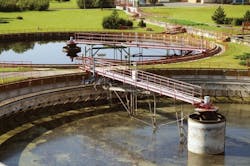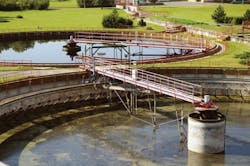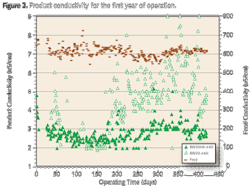Super Sludge: Harnessing Wastewater's Potential
The treatment of sewage sludge will be a key theme at this year's international trade fair, IFAT ENTSORGA. With governments across Europe backing anaerobic digestion for the treatment of food waste, what does this mean for wastewater? Lis Steadman looks at the current state of the market and regulatory difficulties of co-digestion.
How to use sewage sludge in a sustainable and positive way is an issue that has long occupied governments across the globe. Interestingly, recent moves by the EC intended to foster beneficial use of food waste have raised an interesting but problematic possibility: co-digestion.
This possibility was raised by an announcement in mid-May by the EC of steps to improve the management of bio-waste in the EU and tap into its significant environmental and economic benefits. The EC noted that biodegradable garden, kitchen and food waste accounts for 88 million tonnes of municipal waste each year and has major potential impacts on the environment, but also considerable promise as a source of renewable energy and recycled materials.
The EC estimates that about 33% of the EU's 2020 target for renewable energy in transport could be met by using biogas from bio-waste, while around 2% of the EU's overall renewable energy target could be met if all bio-waste was turned into energy – hence the interest.
| Trend:research study Across Europe, approaches differ, as a report from German trend and market researchers trend:research revealed. This report found that using sludge as an agricultural fertiliser was banned in Switzerland in autumn 2008 and now almost all of the material is incinerated. It also showed that Denmark is planning to move gradually away from using sewage sludge in agriculture, which is currently its main disposal route. According to the trend:research experts there are good market opportunities in the country in future for manufacturers of mono-incineration plants. In eastern and southern Europe, volumes of municipal sludge will rise strongly in the coming years as more and more systems are connected to efficient sewage plants, the report predicts. In 2008 on average less than 1% of sewage sludge was processed for energy in eastern Europe in 2008. But in Poland in particular, as the country progresses with adapting to EU law, co-incineration in waste incineration plants could increase. However, the report warns, construction of such co-incineration plants is being hampered there by bureaucratic obstacles and problems of acceptance among the population. In the forecast the analysts expect the figure for processing sewage sludge into energy to rise to 50% across Europe. |
The EC observed: "Good quality compost and digestate from anaerobic digestion would improve resource efficiency by partially replacing non-renewable mineral fertilisers as well as by maintaining the quality of EU soils."
The most promising options are composting and anaerobic digestion, the EC says – but good quality input is crucial. In most cases, separate collection of bio-waste is necessary. Here, member states' very different policies for bio-waste management (some have ambitious policies and others take little action) will prove critical.
The other side of the equation, sewage sludge, is increasingly being digested as the pathogens in raw sludge make it unsuitable under current legislation for many potential applications. One obvious solution would be to co-digest food wastes with sewage sludge to leverage the existing digester capacity, rather than building expensive new digesters specifically for food wastes.
Digestion is one of a range of options used to deal with sewage sludge, and one that lends itself to the current impetus to generate renewable and sustainable energy from waste. Sewage sludge has been traditionally used as fertiliser, as an added material for landscaping or in cement and brick works. It can also be digested to produce biogas (and from that, power), or incinerated (again producing power) or it can simply be disposed of in some way.
Legislation may have considerably reduced the potential for using sludge as a fertiliser, but the quantity being created is increasing as requirements for cleaner wastewater are being implemented. Germany is a case in point: figures show that in 2008, around 2.1 million tonnes of sludge from municipal wastewater treatment plants was disposed of in some way – around 53% was incinerated, a diminishing 29% went for use as an agricultural fertiliser, and 16% was composted, used in landscaping or for reclaiming pit tips and old industrial sites.
In Germany, special permission is required to simply dump the sludge so just 0.1% goes via this route. The trends vary from region to region – in Berlin and Hamburg all sludge is thermally processed, but in Mecklenburg-Vorpommern 86% goes to agriculture, with Baden-Württemberg thermally processing 87%. One of the biggest issues for co-digestion is the considerable difference between the residues from local authority and industrial wastewater treatment plants, and indeed other waste streams that might be suitable for co-disposal. There are many different strategies for processing both within Germany and across Europe as a whole (see box).
German Biogas Association engineer David Wilkinson outlines the issues inherent in co-digesting sewage and other wastes in that country.
"In Germany we have to differ between sewage sludge and industrial sludges, which are wastes according to our law. For example, industrial sludges from making drinks go to a normal biogas digester, which treats the waste," he says.
In Germany, most biogas plants are for agricultural energy crops, he says, with far fewer for other types of waste. This is because of the variation in profitability – with agricultural produce, companies make money from harvesting the crop and from their use as a biogas source. With other wastes the money comes from the companies wanting to get rid of their by-products. Because of the higher levels of compensation for the former, the two types of waste are not mixed.
He adds: "Sewage sludge is a separate thing. There are small places where there is no network and the sludges from these small sewage treatment works go to biogas plants. But bigger sewage treatment works have large digesters that don't work so efficiently to stabilise sludge. In Germany only 10% of sewage sludge can be taken to the field, the rest is burned. There are too many heavy metals and the criteria are high. Clients in the agricultural field want to use it as a fertiliser – but in Germany it is really complicated, even for us here."
For the inefficient wastewater treatment plant digesters to treat other wastes would also be a difficult task. Wilkinson explains that the regulatory systems are a key issue: "For waste treatment at a biogas plant, the waste treatment regulations have to be followed. With sewage sludge you have to take account of the sewage sludge regulations. The two are not in harmony. In the end if you want to take the digestate for agricultural use, you also have to take account of the fertilisation regulations."
There is a European Directive on by-products that also distinguishes between organic waste and animal manure, with different requirements for each. With the different criteria that have to be fulfilled, beginning to mix in sewage sludge would involve fulfilling multiple sets of standards, he notes, which would become very complicated.
UK water industry trade body CIWEM held a conference in October 2009 that tackled these issues and also picked out several key challenges. Iain Notman, the project manager for a Defra/DECC Anaerobic Digestion project, outlined the European co-digestion drivers – the Climate Change Act, which asks for a 34% drop below 1990 levels in greenhouse gas emissions; the EU Renewable Energy Directive, which asks for 15% of the UK's energy to come from renewable sources; and the EU Landfill Directive, which wants the amount of biodegradable waste sent to landfill to reduce to 35% of that produced in 1995.
The importance of anaerobic digestion (AD) in the UK approach is seen in a number of initiatives ranging from the Low Carbon Transition Plan to the biomass and waste strategies. AD is seen as the solution to a number of problems – it produces renewable energy, mitigates methane emissions from agriculture, diverts organic wastes from landfill and produces an organic fertiliser. The ambition is for the UK to be a world leader in AD, using the country's well-established system of wastewater treatment plant digesters as the hubs of a national infrastructure, processing feeds other than sewage where they have the spare capacity. The biosolids and the co-digested materials would be recycled to land.
The independent Anaerobic Digestion Task Group published an implementation plan last July. This made 46 recommendations for practical actions by government and stakeholders to achieve a set of shared goals. There will need to be a regulatory framework for co-digestion and for injecting biomethane into the gas grid as well as monitoring and reporting of the uptake of AD.
However, the "waste" status of the inputs will need to be clarified in guidance documents, and it will be necessary to ensure current work on regulation of digestate covers digestate from all potential feedstocks.
There will also need to be clarification of the regulations and thresholds that trigger exemptions to standard permits and bespoke permits for farm, industrial, commercial and municipal wastes and for sewage sludge. Regulatory arrangements for the production and use of digestate from co-digestion of sewage sludge and other feedstocks will also have to be clarified and defined.
Severn Trent Water's Ken Shapland, who is CIWEM's president, gave a water industry perspective that stressed the need for a clear and robust environmental and economic regulatory framework that facilitates co-digestion of sewage sludge with other feedstocks and enables the appropriate use of the resulting digestate.
He confirmed that the sector did have some capacity for co-digestion, although some companies have more headroom for additional wastes than others. The water sector is keen to help delivery of AD to meet government objectives, but again he pointed out that sewage sludge and waste are covered by different regulatory regimes.
The AD Task Group's Regulation workstream recommended that the "waste" status of the inputs should be clarified in the guidance documents, and that Ofwat should clarify the financial regulation of the new and existing AD assets. Other issues, some regulatory and risk-management focused and others of a practical nature (such as ensuring input quality and the ability to separate contaminants), were outlined at the conference and in the AD Task Group documentation.
Clearly there are strong drivers that will apply with greater or lesser force across Europe depending on each country's current national regulations and sludge disposal preferences. Technically, co-digestion is eminently possible but governmental willingness backed by clear regulation and incentives will undoubtedly drive this market.
More Water & WasteWater International Current Issue Articles
More Water & WasteWater International Archives Issue Articles



